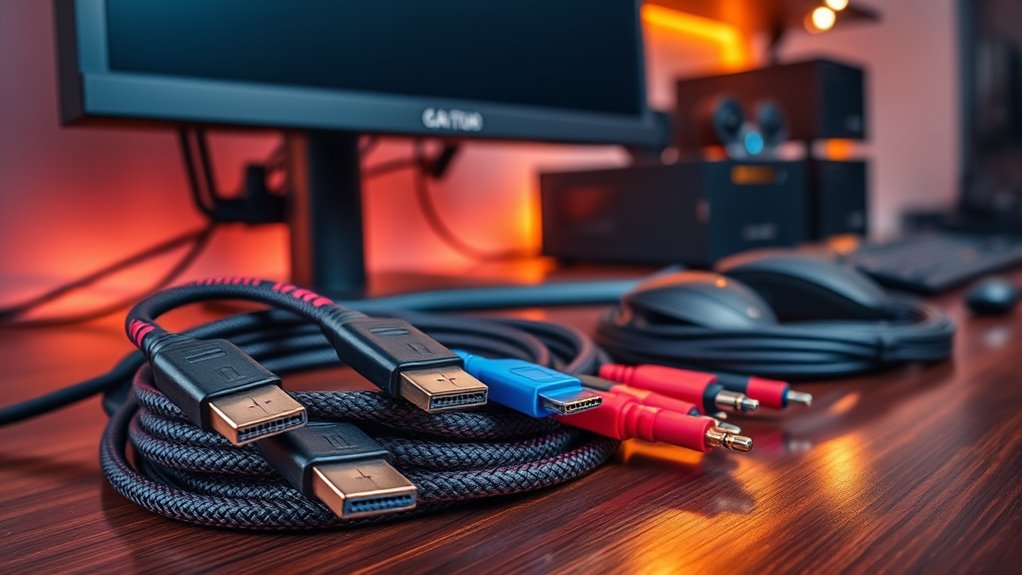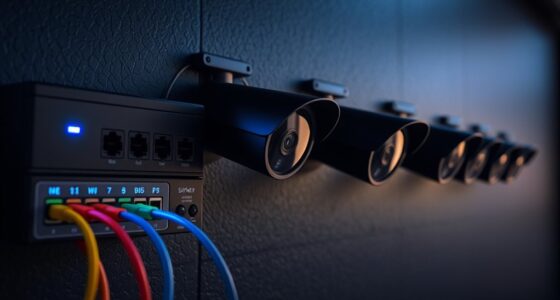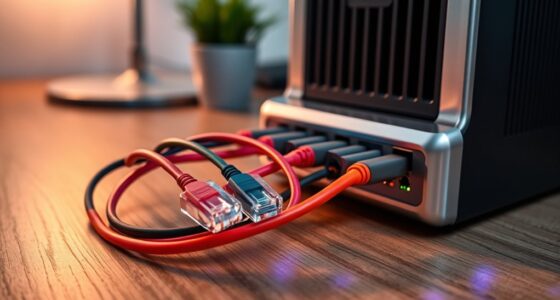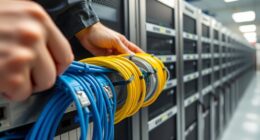To choose the right cables for gaming and streaming, consider your devices and setup size. Use HDMI for high-quality video and audio, and DisplayPort for higher resolutions or multiple monitors. For stable internet, opt for shielded Ethernet cables that support your speed needs. Verify cables are compatible, durable, and properly shielded to prevent interference. Knowing these essentials helps you set up a reliable, high-performance system—stay tuned to learn more about selecting and maintaining the best cables for you.
Key Takeaways
- Select cables with high bandwidth and shielding to ensure stable, high-quality signals for gaming and streaming.
- Match cable types (HDMI, DisplayPort, Ethernet) to device specifications for compatibility and optimal performance.
- Use durable, well-insulated cables to withstand daily use and prevent signal degradation.
- Consider cable length carefully to avoid signal loss and maintain a tidy, organized setup.
- Regularly inspect and upgrade cables to maintain reliable connections and high streaming quality.
Understanding Different Types of Cables for Gaming and Streaming
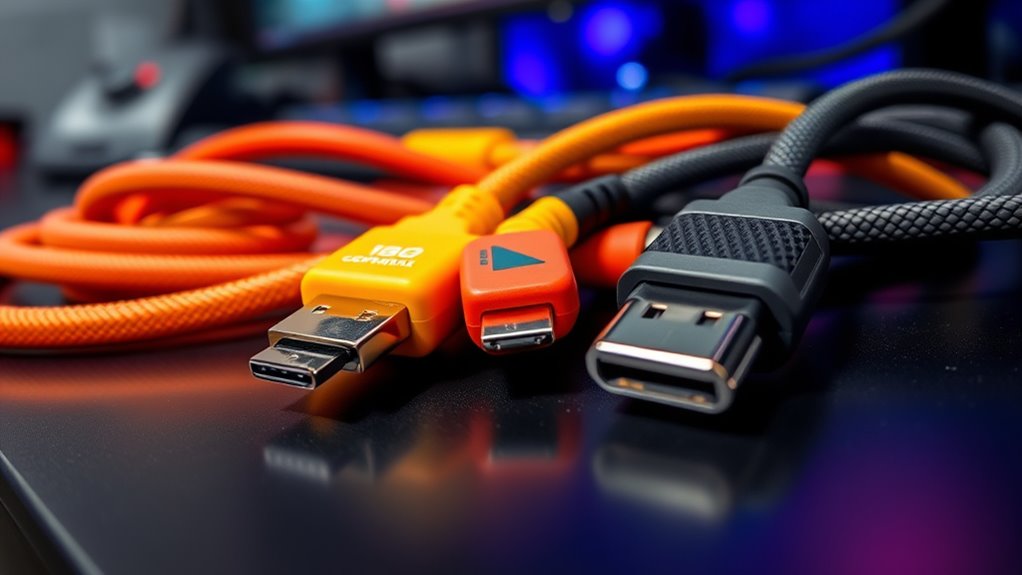
Have you ever wondered which cables are best suited for gaming and streaming? When choosing connections, you’ll find options like wireless options and traditional cables. Wireless options offer convenience and reduce clutter, allowing you to move freely without worrying about cable length or damage. However, they can sometimes face issues like interference or latency, which might impact your gaming experience. On the other hand, cable durability is a key factor to contemplate. High-quality cables are built to withstand daily use, bending, and tension, ensuring a reliable connection over time. Whether you choose wireless or wired, understanding the differences helps you make smarter decisions. Durable cables might cost a bit more initially, but they save you hassle and replacements in the long run. Additionally, considering cable durability can significantly influence your overall satisfaction and device longevity. For example, integrating Kia Tuning quality standards into cable manufacturing can improve the robustness and lifespan of your cables.
HDMI: The Standard for High-Quality Video and Audio

When it comes to delivering crisp video and clear audio, HDMI cables are the go-to choice for gamers and streamers alike. They support high video resolution, from Full HD to 4K and even 8K, ensuring sharp images on your display. HDMI also handles a variety of audio formats, including Dolby Atmos and DTS:X, providing immersive sound experiences. This cable transmits both video and audio signals over a single connection, simplifying setup and reducing clutter. With HDMI, you’ll experience minimal lag, high bandwidth, and reliable performance, making it ideal for gaming and streaming. Whether you’re connecting a gaming console, PC, or streaming device, HDMI guarantees high-quality visuals and audio, elevating your entertainment experience. It’s the standard for modern, high-definition media. reliable performance is essential for seamless gaming and streaming sessions. Additionally, choosing the right HDMI cable with adequate bandwidth ensures optimal transmission for high-resolution content. To further enhance your experience, selecting cables with premium build quality can help prevent signal degradation over longer distances and ensure longevity. Furthermore, selecting cables with robust shielding can reduce electromagnetic interference, maintaining signal integrity and providing a consistent experience.
DisplayPort: A Versatile Choice for Gamers and Streamers

DisplayPort has become a popular choice for gamers and streamers because of its versatility and high performance. Its advantages include supporting higher resolutions and refresh rates, making it ideal for demanding gaming setups and smooth streaming. With versatile connectivity options, DisplayPort easily connects to various devices like monitors, gaming consoles, and docking stations, reducing the need for multiple cables. It also supports daisy chaining multiple monitors, which can enhance your multitasking and immersive gaming experiences. Additionally, DisplayPort offers robust audio transmission, ensuring high-quality sound alongside visuals. Its durability and reliable data transfer make it a dependable choice for your gaming and streaming needs. Overall, DisplayPort’s versatility and performance give you a seamless, high-quality connection that keeps your setup future-proof. Furthermore, its high bandwidth capacity allows for the transmission of uncompressed video and audio signals, supporting the latest high-definition content. As AI-driven innovations continue to improve hardware compatibility, DisplayPort remains a reliable solution for maintaining optimal performance in gaming and streaming environments. The advanced cable design also contributes to its durability and consistent connectivity over extended use.
Ethernet Cables: Ensuring Stable Network Connections

Choosing the right Ethernet cable can make a big difference in your gaming and streaming experience. You’ll want to contemplate different cable types and speeds to match your network needs. Proper installation tips will help you get the most stable and reliable connection possible.
Cable Types and Speeds
Ethernet cables play a pivotal role in providing a stable and fast network connection for gaming and streaming. The right cable type and speed guarantee minimal lag and smooth performance. Cat5e supports speeds up to 1 Gbps, suitable for standard gaming, while Cat6 and Cat6a handle up to 10 Gbps, ideal for high-bandwidth streaming. Cable insulation impacts durability and interference resistance, while connector types guarantee compatibility with your devices. Choose shielded cables for noisy environments, unshielded for cleaner setups. The signal integrity of your connection can be significantly improved by selecting cables with proper shielding and insulation, ensuring consistent performance. Proper cable selection not only improves speed but also helps prevent issues like popping or lag during gameplay or streaming. Selecting the right cable also involves considering the network environment, which can influence the choice of shielding and insulation types for optimal performance. Here’s a quick comparison:
| Cable Type | Max Speed | Cable Insulation & Connector Type |
|---|---|---|
| Cat5e | 1 Gbps | PVC insulation, RJ45 connector |
| Cat6 | 10 Gbps | Foil/Drip insulation, RJ45 connector |
| Cat6a | 10 Gbps | Shielded insulation, RJ45 connector |
Additionally, selecting the appropriate cable can help optimize network performance by reducing interference and maintaining stable connections.
Proper Installation Tips
To guarantee your network remains stable and fast, proper Ethernet cable installation is essential. Start by choosing cables with adequate cable shielding to prevent interference, especially in busy or electronic-heavy environments. Ensure your connectors are compatible with your devices; mismatched connectors can cause connection issues or signal loss. When installing, keep cables off the ground and avoid sharp bends that can damage the shielding or internal wiring. Use high-quality connectors and ensure they’re securely plugged in to maintain a solid connection. Label your cables for easy management and future troubleshooting. Also, avoid running Ethernet cables parallel to power lines to minimize interference. Proper installation not only preserves signal integrity but also extends the lifespan of your cables, providing a consistently stable network for gaming and streaming. Additionally, selecting durable cables designed for outdoor or heavy use can further improve reliability and longevity. Considering cable quality and manufacturer standards can also help ensure your setup remains dependable over time. To further enhance performance, opt for cables with high bandwidth capacity to support faster data transmission rates and future-proof your network.
USB Cables and Connectors for Streaming Equipment
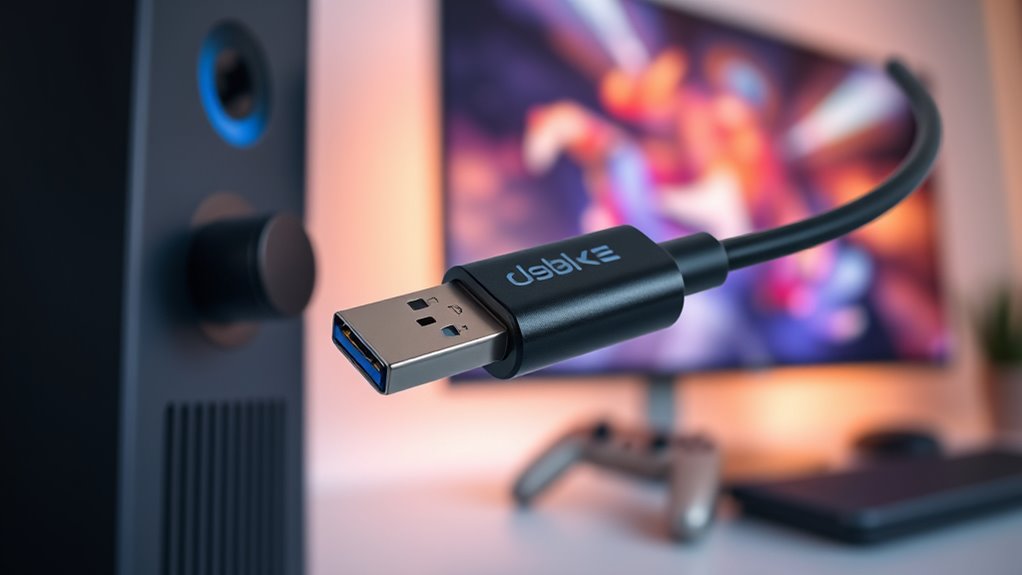
When setting up your streaming equipment, selecting the right USB cables and connectors is crucial for guaranteeing reliable data transfer and minimal latency. USB C compatibility is necessary because it supports faster data speeds and delivers power efficiently, reducing connection issues. Look for cables that match your device’s specifications to avoid compatibility problems. Good cable management tips include using cable clips or sleeves to keep cords organized and prevent tangling, which can cause signal degradation. Choosing high-quality USB C cables ensures durability and consistent performance. Remember to verify that your connectors support the necessary data transfer rates for streaming, such as USB 3.1 or higher. Proper cable selection and management help maintain a smooth, professional streaming setup with fewer interruptions.
Choosing the Right Cable for Your Gaming Console or PC

When selecting a cable for your gaming console or PC, you need to guarantee it’s compatible with your device to avoid connection issues. Signal quality matters too, as a poor cable can cause lag or degraded visuals, so choose one that supports high data transfer rates. Don’t forget to take into account cable length, balancing enough reach without sacrificing performance or cluttering your setup. Additionally, consider signal integrity aspects, such as ensuring your setup creates a comfortable environment that enhances your gaming or streaming experience. Being aware of privacy policies and the use of cookies can also help you understand how your data is managed while browsing for the right accessories. Paying attention to asset division laws in your area can also inform you about legal standards affecting your setup and data security.
Compatibility With Devices
Ensuring your chosen cable is compatible with your gaming console or PC is crucial for seamless performance. Device compatibility means selecting a cable that works with your specific device model, preventing connection issues. Check your console or PC’s specifications to identify the supported connection types. Plug compatibility is equally important; using the right connector ensures a secure fit and maximum data transfer. For example, if your device supports HDMI, avoid using DisplayPort cables, and vice versa. Confirm that the cable’s connectors match your device’s ports to prevent damage or malfunction. Before purchasing, verify compatibility details in the product description or user manual. Properly matching your cable to your device guarantees a smooth gaming or streaming experience without connectivity setbacks. Additionally, understanding AI technology can help you choose cables designed to support high-bandwidth data transfer, enhancing performance during intensive gaming or streaming sessions. Recognizing device specifications is essential to ensure that your cable meets the necessary requirements for optimal performance.
Signal Quality Factors
Choosing the right cable isn’t just about compatibility; signal quality plays a key role in your gaming and streaming experience. Poor signal quality can cause lag, stuttering, or degraded visuals. Signal interference from nearby electronic devices can disrupt your connection, leading to inconsistent performance. To combat this, look for cables with strong shielding effectiveness, which reduces the impact of electromagnetic interference. High-quality shielding helps maintain a stable signal, ensuring smooth gameplay and clear streams. Additionally, check for cables that support high bandwidth and low latency to preserve the integrity of your data. Investing in well-shielded cables with minimal signal interference ensures you get the best possible quality, making your gaming and streaming sessions more enjoyable and reliable.
Cable Length Considerations
Selecting the appropriate cable length is crucial to maintaining ideal performance for your gaming console or PC. Too long a cable can cause signal degradation and clutter your setup, while too short may restrict your movement or device placement. Measure the distance between your device and the power source or monitor before purchasing. Consider cable flexibility as well; a flexible cable makes routing easier around furniture and tight spaces, reducing strain on connectors. A cable that’s too stiff might be difficult to manage, risking damage over time. Opt for a cable length that provides enough slack for comfortable positioning without excess coiling. This balance ensures reliable signals and a tidy setup, enhancing your gaming and streaming experience.
Tips for Selecting Cables Based on Your Setup and Needs

To pick the right cable for your gaming and streaming setup, you need to contemplate how your devices connect and what your priorities are, such as speed, resolution, or convenience. Start by examining the connector types—HDMI, DisplayPort, or USB—ensuring compatibility with your devices. Next, consider cable shielding; well-shielded cables reduce interference, giving you clearer audio and video signals. If you’re streaming high-resolution content or gaming at 4K, opt for cables with robust shielding and high-quality connectors to maintain signal integrity. For setups with multiple devices, choose cables that match your ports and offer durability. By evaluating these factors, you’ll select cables that deliver ideal performance tailored to your setup’s demands.
Maintaining and Upgrading Your Cables for Optimal Performance

Once you’ve picked the right cables for your setup, keeping them in top condition is key to maintaining ideal performance. Regularly inspect your cables for signs of wear, such as fraying or loose connections, to guarantee cable durability. Proper cable management enhances both aesthetics and functionality, preventing tangling and reducing stress on connectors. Use cable ties or sleeves to organize your setup neatly, which also minimizes accidental pulls or damage. Upgrading cables when needed ensures optimal data transfer and signal quality, especially for high-bandwidth tasks like gaming and streaming. Avoid running cables across heat sources or in high-traffic areas to prolong their lifespan. Maintaining and upgrading your cables with care assures consistent performance, saving you time and avoiding costly replacements.
Frequently Asked Questions
How Do I Determine the Best Cable Length for My Gaming Setup?
You determine the best cable length by measuring the distance from your gaming console or PC to your monitor or router, adding a little extra for flexibility. Opt for a cable that’s long enough to avoid tension, but not so long it causes signal attenuation. Consider cable durability as well; a sturdy, well-shielded cable minimizes signal loss over longer runs, ensuring smooth gaming and streaming experiences without interruptions.
Are There Specific Cables Recommended for VR Gaming and Streaming?
Think of the right cables as the bridge connecting your virtual world and real one. For VR gaming and streaming, look for HDMI cables with high VR compatibility and at least HDMI 2.0 or higher for smooth streaming quality. USB-C cables are excellent for data transfer and power, while high-quality DisplayPort cables guarantee crisp visuals. Selecting cables with these specs helps you stay immersed in your game without a hitch.
What Are the Signs That My Cable Needs Replacing?
You’ll know your cable needs replacing if you notice signs of cable durability issues like fraying or exposed wires. Signal degradation is another key sign—if your connection becomes unstable, laggy, or drops unexpectedly, it’s time for a new cable. Regularly check for physical damage and test the connection quality; if problems persist despite troubleshooting, replacing the cable guarantees smooth gaming and streaming sessions.
How Do I Prevent Signal Interference Between Multiple Cables?
To prevent signal interference between multiple cables, guarantee proper cable shielding, which blocks external electromagnetic interference. Keep cables organized by signal decluttering, avoiding tangling and crossing power cords with data cables. Use cable clips or sleeves to separate different types of connections, and maintain adequate distance between high-power and sensitive cables. Regularly check for damaged or loose connections to keep signals clear and prevent interference effectively.
Can I Use Different Cable Types Interchangeably Without Performance Loss?
You can’t always play it by ear when it comes to cable types; using different cables interchangeably can cause performance effects. Cable compatibility varies, and mismatched cables might not deliver the same speed or stability. To guarantee peak performance, stick to recommended cables for your setup. Mixing and matching might seem harmless, but it’s like putting square pegs in round holes—your signal quality could suffer, especially during intense gaming or streaming sessions.
Conclusion
Choosing the right cables can boost your gaming and streaming experience markedly. Did you know that a stable Ethernet connection can reduce lag by up to 80%? By selecting the appropriate HDMI, DisplayPort, or USB cables, and maintaining them properly, you guarantee smooth visuals and seamless audio. Upgrading your cables as needed keeps your setup performing at its best, so you can enjoy top-quality gaming and streaming without interruptions.
